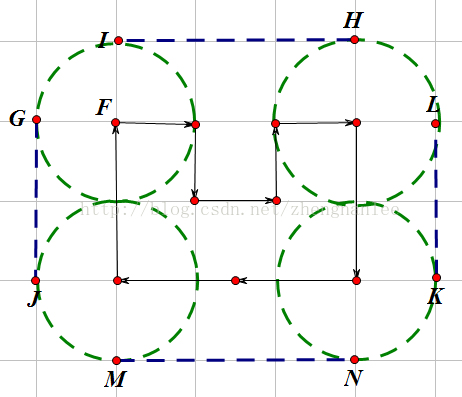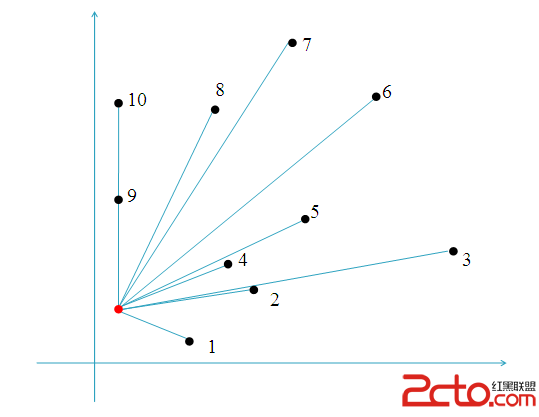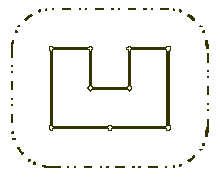Description
Once upon a time there was a greedy King who ordered his chief Architect to build a wall around the King’s castle. The King was so greedy, that he would not listen to his Architect’s proposals to build a beautiful brick wall with a perfect shape and nice tall towers. Instead, he ordered to build the wall around the whole castle using the least amount of stone and labor, but demanded that the wall should not come closer to the castle than a certain distance. If the King finds that the Architect has used more resources to build the wall than it was absolutely necessary to satisfy those requirements, then the Architect will loose his head. Moreover, he demanded Architect to introduce at once a plan of the wall listing the exact amount of resources that are needed to build the wall.
Your task is to help poor Architect to save his head, by writing a program that will find the minimum possible length of the wall that he could build around the castle to satisfy King’s requirements.
The task is somewhat simplified by the fact, that the King’s castle has a polygonal shape and is situated on a flat ground. The Architect has already established a Cartesian coordinate system and has precisely measured the coordinates of all castle’s vertices in feet.
Input
The first line of the input file contains two integer numbers N and L separated by a space. N (3 <= N <= 1000) is the number of vertices in the King’s castle, and L (1 <= L <= 1000) is the minimal number of feet that King allows for the wall to come close to the castle.
Next N lines describe coordinates of castle’s vertices in a clockwise order. Each line contains two integer numbers Xi and Yi separated by a space (-10000 <= Xi, Yi <= 10000) that represent the coordinates of ith vertex. All vertices are different and the sides of the castle do not intersect anywhere except for vertices.
Output
Write to the output file the single number that represents the minimal possible length of the wall in feet that could be built around the castle to satisfy King’s requirements. You must present the integer number of feet to the King, because the floating numbers are not invented yet. However, you must round the result in such a way, that it is accurate to 8 inches (1 foot is equal to 12 inches), since the King will not tolerate larger error in the estimates.
Sample Input
9 100
200 400
300 400
300 300
400 300
400 400
500 400
500 200
350 200
200 200
Sample Output
1628
题意
给出平面内指定多个点,求与它们所围成的区域相距为d的最少线段长度,也就是围成凸包的边长+半径为d的圆的周长~
既然知道了这个,就差写代码AC咯~
说到凸包,我也是第一次接触,只是看了一下凸包的思想,然后直接做,没想到考虑不周,错了好多好多好多次!
下次记得带模板~

思路
- 先对这N个点进行排序,排序的依据有两种,一种是按照纵坐标优先,横坐标次之由小到大排序,另一种是极角排序,它需要找到平面内最左下角的点,然后以该点为起点,连接其他点,由其两点之间与x轴夹角,从下到上排序。
- 排序完成之后,我们需要一个栈。
- 逆时针或者顺时针每次检测三个点,用叉积判断这三个点所连接的两个线段是左转还是右转,若左转,入栈,若右转,说明此时为凹。则让第二个点出栈,第三个点入栈,别忘了每一次检测都要向后扫描。
- 检测完之后栈中便是凸包各个顶点的坐标。
- 按照顺序求每两点距离,然后相加。
- 计算圆的周长。
- AC

AC 代码
#include<iostream>
#include<algorithm>
#include<cmath>
#include<stdio.h>
using namespace std;
#define PI acos(-1)
struct point
{
double x;
double y;
double distance(const point &b)const //计算距离
{
return hypot(x-b.x,y-b.y);
}
} ;
point a[1005];
struct stack
{
point data[1005];
int top;
} st;
point minn;
int crossLeft(point p0,point p1,point p2) //判读左转还是右转
{
return (p1.x-p0.x)*(p2.y-p0.y)-(p1.y-p0.y)*(p2.x-p0.x);
}
bool cmp(point p1,point p2)
{
int tmp=crossLeft(a[0],p1,p2);
if(tmp>0) return true;
else if(tmp==0&&a[0].distance(p1)<a[0].distance(p2))return true;
else return false;
}
void init(int n)
{
int i,k=0;
point p;
cin>>a[0].x>>a[0].y;
p.x=a[0].x;
p.y=a[0].y;
for(i=1; i<n; i++)
{
cin>>a[i].x>>a[i].y;
if( (p.y>a[i].y) || ((p.y==a[i].y)&&(p.x>a[i].x)) )
{
p.x=a[i].x;
p.y=a[i].y;
k=i;
}
}
a[k]=a[0];
a[0]=p;
sort(a+1,a+n,cmp);
}
int main()
{
int N,L;
cout.sync_with_stdio(false); //解除同步
while(cin>>N>>L)
{
init(N);
for(int i=0; i<2; i++)
st.data[i]=a[i]; //前两个点入栈
st.top=1;
for(int i=2; i<N; i++)
{
st.data[++st.top]=a[i]; //新点进栈
while(st.top>1&&crossLeft(st.data[st.top-2],st.data[st.top-1],st.data[st.top])<=0) //向后遍历判断是否存在凹的区域
st.data[st.top-1]=st.data[st.top],st.top--; //存在,出栈一个点
}
double l=0.0;
for(int i=0; i<st.top; i++)
l+=st.data[i].distance(st.data[i+1]); //求长度
l+=st.data[st.top].distance(st.data[0])+2*PI*L; //圆的周长
printf("%d\n",(int)(l+0.5));
}
}



